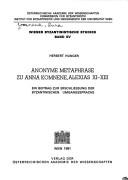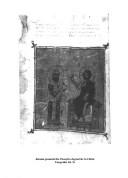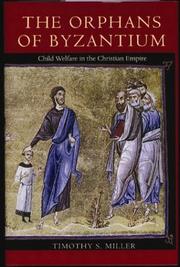| Listing 1 - 9 of 9 |
Sort by
|
Book
ISBN: 9780140455274 0140455272 Year: 2009 Publisher: London New York Penguin
Abstract | Keywords | Export | Availability | Bookmark
 Loading...
Loading...Choose an application
- Reference Manager
- EndNote
- RefWorks (Direct export to RefWorks)
Anna Comnena (1083-1153) wrote The Alexiad as an account of the reign of her father, the Byzantine Emperor Alexius I. It is also an important source of information on the Byzantine war with the Normans, and on the First Crusade in which Alexius participated. While the Byzantines were allied to the Crusaders, they were nonetheless critical of their behaviour and Anna's book offers a startlingly different perspective to that of Western historians. Her character sketches are shrewd and forthright - from the Norman invader Robert Guiscard ('nourished by manifold evil') and his son Bohemond ('like a streaking thunderbolt') to Pope Gregory VII ('unworthy of a high priest'). The Alexiad is a vivid and dramatic narrative, which reveals as much about the character of its intelligent and dynamic author as it does about the fascinating period through which she lived. - Publisher.
Alexius --- Byzantine Empire --- Empire byzantin --- History --- Histoire --- Alexios --- Comnenus, Alexius, --- Komnēnos, Alexios, --- Kumnīn, Aliksiyūs, --- Alexis --- Comnène, Alexis, --- Komnin, Alekseĭ,

ISBN: 3110158132 9783110158137 Year: 2001 Volume: 40 Publisher: Berolini ; Novi Eboraci Walter de Gruyter
Abstract | Keywords | Export | Availability | Bookmark
 Loading...
Loading...Choose an application
- Reference Manager
- EndNote
- RefWorks (Direct export to RefWorks)
Comnena, Anna, --- Comnène, Anne. --- Alexius --- Alexios --- Comnenus, Alexius, --- Komnēnos, Alexios, --- Kumnīn, Aliksiyūs, --- Alexis --- Comnène, Alexis, --- Komnin, Alekseĭ, --- Byzantine Empire --- History --- Comnena, Anna, - b. 1083. - Alexiad
Book
ISBN: 9782729833107 Year: 2007 Publisher: Paris : Ellipses,
Abstract | Keywords | Export | Availability | Bookmark
 Loading...
Loading...Choose an application
- Reference Manager
- EndNote
- RefWorks (Direct export to RefWorks)
En 1081, l'Empire byzantin, l'héritier de l'Empire romain d'Orient, est sur le point de sombrer dans le chaos : à l'intérieur une série de rébellions a fragilisé le pouvoir ; à l'extérieur des ennemis menacent les frontières : au nord les Petchénègues, à l'est les Turcs, à l'ouest les Normands. C'est alors qu'un jeune général, issu d'une famille aristocratique, prend le pouvoir par un coup d'Etat. Alexis Ier Comnène (1081-1118) connaît l'un des plus longs règnes de l'histoire byzantine : il réussit à écarter le danger extérieur, réorganise les finances et l'administration, se fait le champion de l'orthodoxie religieuse et ouvre l'Empire byzantin aux relations avec l'Occident. Son œuvre a permis aux Comnènes de rester sur le trône tout un siècle. Cet ouvrage permet une découverte d'une civilisation toute de faste, de spiritualité et de violence : où l'empereur déploie les merveilles de Byzance devant les étrangers, où les fondations d'églises et de monastères reflètent le souci angoissé des Byzantins de réparer leurs fautes sur Terre, où la coutume était d'aveugler les conspirateurs au fer rouge, où les ennemis d'hier peuvent devenir les plus fidèles soutiens de l'Empire, où des complots contre l'empereur sont fomentés par ses familiers et ses plus proches parents. A cette Byzance éternelle le règne d'Alexis Ier donne un nouveau visage : les hérétiques sont brûlés en place publique, les liens entre les hommes se resserrent et se hiérarchisent, les chevaliers de la Première croisade prêtent serment à l'Empereur avant d'aller conquérir des royaumes en Terre sainte : Bohémond, Godefroi de Bouillon, Hugues de Vermandois et bien d'autres... Fondée sur une abondante historiographie médiévale et moderne, cette biographie tente de dégager une image objective de cet empereur rusé et indéchiffrable, tantôt terrible, tantôt indulgent.
Emperors --- Empereurs --- Biography. --- Biographies --- Alexius --- Byzantine Empire --- Empire byzantin --- History --- Histoire --- Alexios --- Comnenus, Alexius, --- Komnēnos, Alexios, --- Kumnīn, Aliksiyūs, --- Alexis --- Comnène, Alexis, --- Komnin, Alekseĭ, --- Alexis 01 (empereur d'orient ; 1057-1118 ) --- Empire byzantin -- civilisation --- Civilisation
Book
ISBN: 0674064992 0674069021 9780674069022 9780674064997 9780674059948 0674059948 Year: 2012 Publisher: Cambridge, Mass. : Belknap Press of Harvard University Press,
Abstract | Keywords | Export | Availability | Bookmark
 Loading...
Loading...Choose an application
- Reference Manager
- EndNote
- RefWorks (Direct export to RefWorks)
According to tradition, the First Crusade began at the instigation of Pope Urban II and culminated in July 1099, when thousands of western European knights liberated Jerusalem from the rising menace of Islam. But what if the First Crusade's real catalyst lay far to the east of Rome? In this groundbreaking book, countering nearly a millennium of scholarship, Peter Frankopan reveals the untold history of the First Crusade.Nearly all historians of the First Crusade focus on the papacy and its willing warriors in the West, along with innumerable popular tales of bravery, tragedy, and resilience. In sharp contrast, Frankopan examines events from the East, in particular from Constantinople, seat of the Christian Byzantine Empire. The result is revelatory. The true instigator of the First Crusade, we see, was the Emperor Alexios I Komnenos, who in 1095, with his realm under siege from the Turks and on the point of collapse, begged the pope for military support. Basing his account on long-ignored eastern sources, Frankopan also gives a provocative and highly original explanation of the world-changing events that followed the First Crusade. The Vatican's victory cemented papal power, while Constantinople, the heart of the still-vital Byzantine Empire, never recovered. As a result, both Alexios and Byzantium were consigned to the margins of history. From Frankopan's revolutionary work, we gain a more faithful understanding of the way the taking of Jerusalem set the stage for western Europe's dominance up to the present day and shaped the modern world.
Crusades --- Barons' Crusade, 1096-1099 --- First Crusade, 1096-1099 --- Princes' Crusade, 1096-1099 --- Alexius --- Alexios --- Comnenus, Alexius, --- Komnēnos, Alexios, --- Kumnīn, Aliksiyūs, --- Alexis --- Comnène, Alexis, --- Komnin, Alekseĭ, --- Byzantine Empire --- History

ISBN: 370010376X 9783700103769 Year: 1981 Volume: Bd. 15 Publisher: Wien Österreichische Akademie der Wissenschaften
Abstract | Keywords | Export | Availability | Bookmark
 Loading...
Loading...Choose an application
- Reference Manager
- EndNote
- RefWorks (Direct export to RefWorks)
Alexius --- Byzantine Empire --- Empire byzantin --- History --- Histoire --- Alexius I Comnenus, Emperor of the East --- -History --- -Alexius I Comnenus, Emperor of the East --- -Alexius --- Alexios --- Comnenus, Alexius, --- Komnēnos, Alexios, --- Kumnīn, Aliksiyūs, --- Alexis --- Comnène, Alexis, --- Komnin, Alekseĭ, --- Alexius - I Comnenus, - Emperor of the East --- Byzantine Empire - History - Alexius I Comnenus, 1081-1118

ISBN: 0853895813 Year: 1996 Volume: 4.1 Publisher: Belfast : Belfast Byzantine enterprises,
Abstract | Keywords | Export | Availability | Bookmark
 Loading...
Loading...Choose an application
- Reference Manager
- EndNote
- RefWorks (Direct export to RefWorks)
Alexius --- Congresses --- Congrès --- Byzantine Empire --- Empire byzantin --- History --- Histoire --- 949.5.03 --- Geschiedenis van Byzantium: Isaac I - Latijnse verovering--(1057-1204) --- Alexius I Comnenus, Emperor of the East --- -Congresses --- -History --- 949.5.03 Geschiedenis van Byzantium: Isaac I - Latijnse verovering--(1057-1204) --- Congrès --- Alexios --- Comnenus, Alexius, --- Komnēnos, Alexios, --- Kumnīn, Aliksiyūs, --- Alexis --- Comnène, Alexis, --- Komnin, Alekseĭ, --- Congresses. --- Byzantium (Empire) --- Vizantii︠a︡ --- Bajo Imperio --- Bizancjum --- Byzantinē Autokratoria --- Vyzantinon Kratos --- Vyzantinē Autokratoria --- Impero bizantino --- Bizantia

ISBN: 0813220793 9780813220796 0813213134 9780813213132 Year: 2003 Publisher: Washington, D.C. : Catholic University of America Press,
Abstract | Keywords | Export | Availability | Bookmark
 Loading...
Loading...Choose an application
- Reference Manager
- EndNote
- RefWorks (Direct export to RefWorks)
Guardian and ward --- Child welfare --- Orphanages --- Guardianships --- Tutelage --- Wards --- Domestic relations --- Trusts and trustees --- Conservatorships --- Interdiction (Civil law) --- Child protective services --- Child protective services personnel --- Children --- CPS (Child protective services) --- Humane societies --- Protection of children --- Family policy --- Public welfare --- Social work with children --- Social work with youth --- Orphan asylums --- Orphans and orphan-asylums --- Law and legislation --- Charities --- Charities, protection, etc. --- Protection --- Institutional care --- Alexius --- Alexios --- Comnenus, Alexius, --- Komnēnos, Alexios, --- Kumnīn, Aliksiyūs, --- Alexis --- Comnène, Alexis, --- Komnin, Alekseĭ,

ISBN: 0813213134 Year: 2003 Publisher: Washington (D.C.) Catholic university of America press
Abstract | Keywords | Export | Availability | Bookmark
 Loading...
Loading...Choose an application
- Reference Manager
- EndNote
- RefWorks (Direct export to RefWorks)
Orphanages --- Child welfare --- Guardian and ward --- Orphelinats --- Enfants --- Tutelle et curatelle --- Protection, assistance, etc. --- Alexius --- Orphan asylums --- Orphans and orphan-asylums --- Children --- Guardianships --- Tutelage --- Wards --- Domestic relations --- Trusts and trustees --- Conservatorships --- Interdiction (Civil law) --- Child protective services --- Child protective services personnel --- CPS (Child protective services) --- Humane societies --- Protection of children --- Family policy --- Public welfare --- Social work with children --- Social work with youth --- Institutional care --- Law and legislation --- Charities --- Charities, protection, etc. --- Protection --- Alexios --- Comnenus, Alexius, --- Komnēnos, Alexios, --- Kumnīn, Aliksiyūs, --- Alexis --- Comnène, Alexis, --- Komnin, Alekseĭ,
Book
ISBN: 1139699024 1139862049 1139860941 1139583875 1139870939 113986520X 1139868799 1139863088 1107037220 1108401945 Year: 2014 Publisher: Cambridge : Cambridge University Press,
Abstract | Keywords | Export | Availability | Bookmark
 Loading...
Loading...Choose an application
- Reference Manager
- EndNote
- RefWorks (Direct export to RefWorks)
This is the first full-scale study of the literary art of Anna Komnene's Alexiad. Her history of her father's reign is well-known and much used by Byzantinists and historians of the First Crusade, but the art with which it shapes its central character has not been fully examined or understood. This book argues that the work is both history and tragedy; the characterization of Alexios I Komnenos is cumulative; it develops; the models for his idealization change; much of the action takes place in his mind and the narrative relays and amplifies his thought while building a dense picture of the world in which he acts. Engaging critically and responsively with other texts, Komnene uses the full range of current literary genres to portray the ideal culture of his rule. She matches her art of literary control to his of government over the adverse forces of his time.
Emperors --- Czars (Emperors) --- Rulers --- Sovereigns --- Tsars --- Tzars --- Kings and rulers --- History and criticism. --- Comnena, Anna, --- Alexius |b I Comnenus, --- Anna Comnena --- Anna Comnena, --- Anna Komnena, --- Anne Comnène --- Comnena, Anna --- Komnene, Anne --- Anne Komnene --- Comnène, Anne, --- Komnena, Anna, --- Komnēnē, Anna, --- Komnina Anna, --- Criticism, Textual. --- Literary art. --- In literature. --- Byzantine Empire --- Byzantium (Empire) --- Vizantii︠a︡ --- Bajo Imperio --- Bizancjum --- Byzantinē Autokratoria --- Vyzantinon Kratos --- Vyzantinē Autokratoria --- Impero bizantino --- Bizantia --- Biography --- Alexius --- Alexios --- Comnenus, Alexius, --- Komnēnos, Alexios, --- Kumnīn, Aliksiyūs, --- Alexis --- Comnène, Alexis, --- Komnin, Alekseĭ,
| Listing 1 - 9 of 9 |
Sort by
|

 Search
Search Feedback
Feedback About
About Help
Help News
News